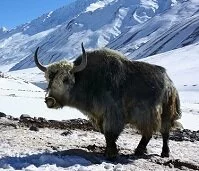Wildlife

Yak
Despite its small size, Nepal has a fairly diverse wildlife as it reaches from the alpine peaks down to the lowlands. The greatest variety comes in the mammal population as there are tigers, deer, leopards, rhinoceros, boars, pandas, bears, marmots, sheep, yak, and rodents like mice. The sea life though is just the opposite as there are many rivers in the country, but they flow fast and there are few places that are real suitable for a wide range of species to live other than in the flatlands near the Indian border. Despite this, there are many small fish and shellfish in these rivers.
The bird life, like the mammal population, is quite diverse, particularly due to migrating birds, although there are a significant number of local birds that remain year-round. Among the birds, peacocks, partridges, ducks, geese, pheasants, and eagles are common. There are only a few amphibians and reptiles in Nepal, the most fearsome being the crocodile, which makes its home along rivers in the country's south.